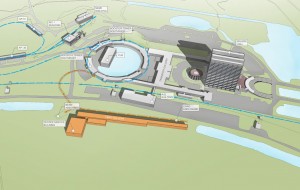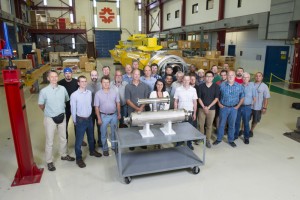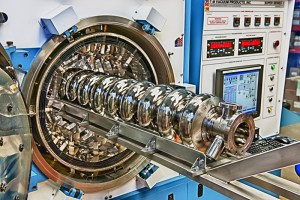The universe’s oldest light hasn’t made a pit stop for 13.82 billion years—beginning its journey just 380,000 years after the big bang. That light, the so-called cosmic microwave background (CMB), serves as a familiar hunting ground for astronomers who seek to understand the universe in its infancy.

The PIP-II accelerator will provide Fermilab with the high-power beams needed to carry out a world-class neutrino program. Image: Fermilab
Even accelerator complexes can use some good, old-fashioned makeovers every now and then. The Proton Improvement Plan II, or PIP-II, is a proposed project to improve Fermilab’s particle accelerator complex with a major hardware overhaul and a powerful boost in its capabilities.
“Every forefront research facility has to be continually renewing itself,” said Steve Holmes, project manager for PIP-II. “Yesterday’s performance is not going to be competitive tomorrow. We’ve done a lot with the Fermilab accelerator complex over the years, but eventually you reach a point where you’ve got to retire some of the really old stuff.”
The headliner for this upgrade is neutrino physics, Holmes said. The next generation of neutrino programs is going to be bigger and more capable than current experiments. With more beam power, Holmes said, the physics reach will be substantial. When PIP-II achieves its design goal, it will deliver the world’s most intense neutrino beam just in time for the Long-Baseline Neutrino Facility to start operations in 2025. The facility will support Fermilab’s flagship research program, the Deep Underground Neutrino Experiment.
“We want high power to support our neutrino program,” said Paul Derwent, deputy project manager. “That means lots of particles at high energy and frequently. To increase the power, we need to be able to increase the number of particles right from beginning.”
PIP-II will allow physicists to accelerate more protons and help them achieve higher energy over a shorter distance. The project will involve retiring Fermilab’s 400-MeV copper linac and building a new 800-MeV superconducting radio-frequency linac as well as replacing the beam transport to the Booster. There will also be upgrades to the laboratory’s Booster, Main Injector and Recycler.
The most ambitious part of the PIP-II upgrade will be the new 800-MeV linear accelerator, which will be built in the infield of the decommissioned Tevatron accelerator and take advantage of significant existing accelerator infrastructure at Fermilab. The location will provide access to existing utilities, while allowing construction to proceed independent of ongoing accelerator operations and retaining possibilities for upgrade paths down the road. The linac design also provides an option for continuous-wave operations, which means delivery of an uninterrupted, rather than pulsed, stream of particles, providing physicists with more beam for other experiments, such as Mu2e.
A large part of this effort involves an international collaboration with India. The Department of Atomic Energy in India has offered to contribute hardware in exchange for the experience of building high-intensity superconducting radio-frequency proton linacs, which they hope to construct in their own country.
“I’m excited to have the chance to retire a bunch of accelerators that were old when I started here 30 years ago,” Holmes joked. “But more seriously, what I find most attractive about this project is the opportunity to do something that will improve the performance of the Fermilab accelerator complex in a manner that will allow us to remain at the forefront both of accelerator-based neutrino physics and our other programs for decades.”

Fermilab has a strong birdwatching community, one that hosts the occasional competition. Photo: Reidar Hahn
In 1971, bird-watchers found a rare bird near a rest stop picnic table in Patagonia, Arizona. As word got out, birders flocked to the rest stop for a glimpse. Looking for the first rare bird, they found a second. And then another. Soon, the rest stop became famous among bird-watchers.
“The reason is not that it was a particularly good area for birds, but that there were a lot of people birding in the area to find the rare birds,” said Peter Kasper, Accelerator Division scientist and lead bird monitor at Fermilab. The events at this rest stop gave name to a birding phenomenon, the Patagonia Picnic Table Effect.
“And there’s something of that at Fermilab,” Kasper said.
Binocular-bearing birders visit Fermilab from near and far, but the Patagonia Picnic Table Effect doesn’t explain all the allure. Kasper also credits Fermilab’s popularity as a birding site to its diversity of species. Birders have found 287 bird species at Fermilab.
Volunteer bird monitors have tracked Fermilab’s birds for 30 years. A small, dedicated crew — led by Kasper — continues to monitor the birds weekly. Even more bird-watchers come for the annual, daylong Christmas Bird Count, a National Audubon Society event. Last year, the site that includes Fermilab, a circle 15 miles in diameter known as the Fermilab Circle, had 106 observers total — more than any other circle in Illinois.
Dave Spleha, member of the Fermilab Ecological Land Management Committee, has been birding at the lab for 20 years. Spleha helps upkeep Kasper’s online diary, an archive of bird sightings. The sightings are organized into five-year survey periods.
“All this data helps us visualize the changes in the bird population over time,” Spleha said.
Fermilab ecologist Ryan Campbell and the rest of Roads and Grounds also find the data useful.
“Birds are an important part of the ecosystems here at Fermilab, and we are grateful for the dedication of the monitors,” Campbell said. “The rigor of the sampling in this long-term study is a benchmark for the quality of data we’re trying to use in order to inform our ecological land management and protection efforts.”
Fermilab hosts a wide variety of birds because it has wide variety of habitat, including wetlands, grasslands and woodlands. The diversity of species attracts bird-watchers, but it also gives Fermilab an advantage in unofficial birding competitions.
The premise of these competitions is simple. One person looks for birds at one site; the other looks for birds at another. The winner is whoever saw the most bird species in a six-hour window.
“He threw down the gauntlet,” Kasper said of a birder friend who forced him into a competition one day. “Illinois Beach State Park versus Fermilab. I didn’t stand a chance.”
Illinois Beach State Park is on Lake Michigan, a magnet for migrating birds. Though Kasper didn’t out-bird his friend that day, sites sans lakefront make easier adversaries.
Glenn Perricone, Fermilab bird monitor and biology major at Elmhurst College, runs competitions every other month with a birder friend at Pratt’s Wayne Woods Forest Preserve.
“We just bird our brains out,” Perricone said. “We go all over the place looking for as many species as we can find. It’s fun. It’s friendly competition.” Perricone usually wins these games, but attributes his success to the many bodies of water at Fermilab, which allow him to crush the competition in shorebirds and waterfowl. The real benefits of species diversity at Fermilab, however, lie elsewhere.
“We see species diversity as the measure of the quality of the habitat,” Kasper said. The goals are to maintain this diversity, an indicator of healthy habitats, continue taking accurate data for Kasper’s web diary, and enjoy birding for what it is — not to win.
“Birding for me is not about the silly competitions,” Perricone said. “It’s about being in nature. I’m out here seeing amazing things that normally people just drive or walk past and don’t even think twice about.”

A Technical Division team rallies around a dressed cavity from the LCLS-II project. Photo: Reidar Hahn
Members of Fermilab’s Technical Division are working on superconducting radio-frequency cavities that are shaped like squatty beads on straight string. These prone, uniformly bulging tubes accelerate the particle beams that shoot through their hollow insides. The team recently achieved a record-high quality factor with a fully dressed cavity for a SLAC-headed project, Linac Coherent Light Source II.
“This has taken a lot of hard work from a very dedicated crew,” said Rich Stanek, Fermilab LCLS-II senior team leader. Stanek acknowledged the entire cavity dressing team and all of the SRF scientists that helped reach this record quality factor.
Quality factor, Q, is a measure of how efficient a particle acceleration cavity is. A higher Q means a cavity is losing less energy, which is more cost-effective.
The two LCLS-II free-electron lasers will produce X-rays to probe a wide variety of materials, exotic and otherwise, at the nanoscale. Fermilab is responsible for designing, developing, building and testing about 150 nine-cell cavities for the LCLS-II superconducting accelerator. The R&D process began one and a half years ago. It includes ensuring that the cavities meet certain Q values during testing.
“This is the first integrated test we did,” said Nikolay Solyak, project support group leader. In an integrated test, everything is checked under real conditions. “The conditions were very close to the cavity’s final condition in a cryomodule.”
In this integrated test, the fully dressed 1.3-gigahertz cavity’s quality factor was 3.1 x 1010 at 2 Kelvin and at a 16-megavolt-per-meter peak surface electric field. This Q exceeds LCLS-II’s goal of 2.7 x 1010 and far surpasses current state-of-the-art standards.

An LCLS-II-type accelerator cavity prepares to be treated with nitrogen, a process that increases the cavity’s quality factor. Fermilab recently reported a record quality factor for LCLS-II-type cavities. Photo: Reidar Hahn
“This quality factor is an extremely important step,” said Slava Yakovlev, SRF department head. “It’s a victory.”
SLAC physicist Marc Ross, LCLS-II cryogenics systems manager, says he’s pleased with the results.
“It’s definitely a victory,” Ross said. “These are some of the highest-quality-factor practical resonators ever built.”
A fully dressed cavity is outfitted with all the components it will wear in the LCLS-II accelerator. This includes a titanium jacket filled with liquid helium chilled to 2 Kelvin, a temperature at which niobium is superconducting. It’s also furnished with power-providing couplers, cavity-squeezing tuners to control frequency, and magnetic shielding. These components add heat and can lower Q, so the team had to develop a way to carry this heat away and keep Q high.
“This record Q is really the sum, the final point, of many years of research,” said Anna Grassellino, Fermi’s Technical Division scientist who leads cavity testing and processing for LCLS-II. “It’s really a miracle of science and technology and engineering coming together and producing an unprecedented quality factor. It opens up a way for machines to operate much more efficiently at a much lower cost.”
Grassellino led the Fermilab effort to apply the breakthrough technology, dubbed nitrogen doping, that helped achieve this record Q. It involves infusing nitrogen into a cavity’s inner niobium surface. Nitrogen doping and other Fermilab discoveries that led to this Q value, such as the removal of magnetic flux through rapid cooling, will become new standards for achieving highly efficient accelerators worldwide.
“This is a critical milestone not only in LCLS-II design, but in other modern accelerator projects including our own project, PIP-II,” Yakovlev said.
But there’s more to be done for LCLS-II.
“We still need to show that the full cryomodule with eight cavities meets specifications,” Grassellino said. “There’s always a next step.”

